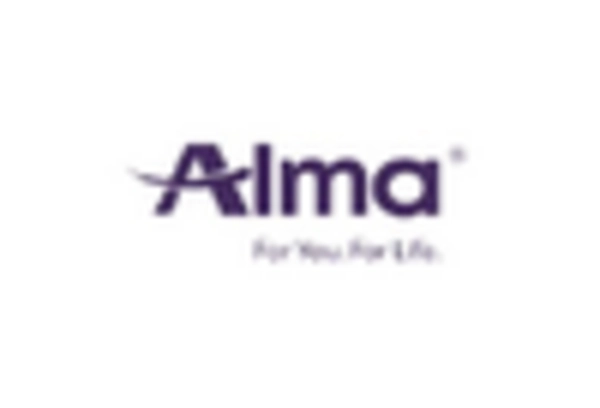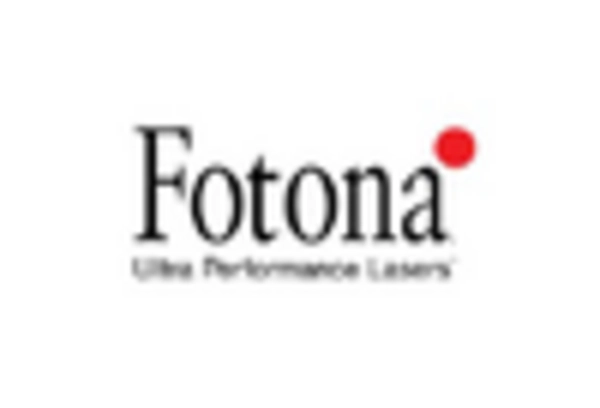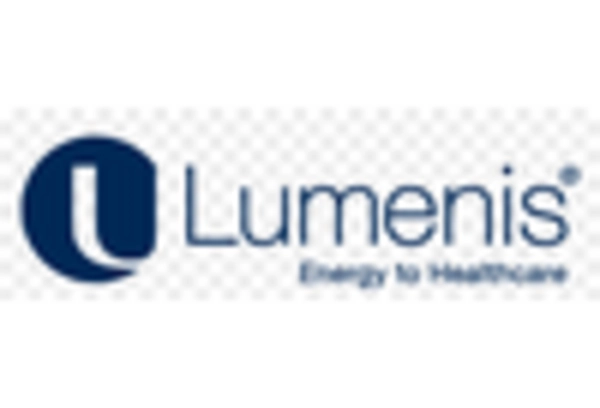Increasing Prevalence of Chronic Diseases
The rising incidence of chronic diseases in Japan is a pivotal driver for the medical lasers market. Conditions such as diabetes, cardiovascular diseases, and various forms of cancer necessitate advanced treatment options. Medical lasers offer minimally invasive solutions that are often preferred by both patients and healthcare providers. According to recent statistics, chronic diseases account for approximately 60% of all deaths in Japan, highlighting the urgent need for effective treatment modalities. This trend is likely to propel the demand for medical lasers, as they are increasingly utilized in surgical procedures, dermatology, and ophthalmology. The medical lasers market is expected to witness substantial growth as healthcare systems adapt to the increasing burden of chronic diseases. This adaptation will enhance patient outcomes and reduce recovery times.
Technological Innovations in Laser Systems
Technological advancements in laser systems are significantly influencing the medical lasers market. Innovations such as fiber lasers, diode lasers, and solid-state lasers are enhancing the precision and efficacy of medical procedures. These advancements not only improve treatment outcomes but also expand the range of applications for medical lasers, including cosmetic surgery, dental procedures, and tissue ablation. The integration of artificial intelligence and robotics into laser systems is also emerging, potentially revolutionizing surgical practices. As of 2025, the medical lasers market in Japan is projected to grow at a CAGR of around 8%, driven by these technological innovations. The continuous evolution of laser technology is likely to attract investments and foster research and development, further propelling market growth.
Government Initiatives and Funding for Healthcare
Government initiatives and funding aimed at improving healthcare infrastructure in Japan are crucial for the medical lasers market. The Japanese government has been actively investing in advanced medical technologies to enhance healthcare delivery and patient outcomes. Programs that support the adoption of innovative medical devices, including lasers, are likely to facilitate market growth. For instance, the government has allocated substantial budgets for healthcare modernization, which includes the procurement of state-of-the-art medical equipment. This financial backing is expected to encourage hospitals and clinics to integrate medical lasers into their treatment offerings, thereby expanding the market. The medical lasers market is poised to benefit from these initiatives, as they align with the broader goals of improving healthcare access and quality.
Rising Awareness and Acceptance of Laser Treatments
The increasing awareness and acceptance of laser treatments among the Japanese population is a notable driver for the medical lasers market. Educational campaigns and the proliferation of information regarding the benefits of laser therapies have contributed to a more informed public. Patients are becoming more proactive in seeking out advanced treatment options, particularly for conditions that were traditionally treated with more invasive methods. This shift in perception is likely to enhance the demand for medical lasers across various specialties, including dermatology, ophthalmology, and surgery. As awareness continues to grow, the medical lasers market is expected to expand, with more healthcare providers adopting laser technologies to meet patient expectations and improve treatment outcomes.
Aging Population and Demand for Aesthetic Procedures
Japan's aging population is a significant driver for the medical lasers market, particularly in the realm of aesthetic procedures. As individuals age, there is an increasing desire for cosmetic treatments that enhance appearance and boost self-esteem. Medical lasers are widely used for skin rejuvenation, hair removal, and tattoo removal, making them essential in the aesthetic industry. The demographic shift towards an older population, with projections indicating that over 30% of the population will be aged 65 and above by 2030, suggests a growing market for aesthetic laser treatments. This trend is likely to stimulate demand for medical lasers, as more individuals seek non-invasive solutions to address age-related concerns, thereby contributing to the overall growth of the medical lasers market.

















Leave a Comment